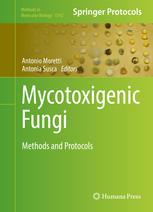

Most ebook files are in PDF format, so you can easily read them using various software such as Foxit Reader or directly on the Google Chrome browser.
Some ebook files are released by publishers in other formats such as .awz, .mobi, .epub, .fb2, etc. You may need to install specific software to read these formats on mobile/PC, such as Calibre.
Please read the tutorial at this link: https://ebookbell.com/faq
We offer FREE conversion to the popular formats you request; however, this may take some time. Therefore, right after payment, please email us, and we will try to provide the service as quickly as possible.
For some exceptional file formats or broken links (if any), please refrain from opening any disputes. Instead, email us first, and we will try to assist within a maximum of 6 hours.
EbookBell Team

4.3
98 reviewsThis thorough volume explores the possibility of detecting and identifying toxigenic fungi, able to produce secondary metabolites known as mycotoxins, which cause severe health problems in humans and animals after exposure to contaminated food and feed, having a broad range of toxic effects, including carcinogenicity, neurotoxicity, and reproductive and developmental toxicity. Beginning with a section on fungal genera and species of major significance along with their associated mycotoxins, the book continues with sections on Polymerase Chain Reaction (PCR)-based methods for the detection and identification of mycotoxigenic fungi, PCR-based methods for multiplex detection of mycotoxigenic fungi, as well as sections on combined approaches and new methodologies. Written for the highly successful Methods in Molecular Biology series, chapters include introductions to their respective topics, lists of the necessary materials and reagents, step-by-step, readily reproducible laboratory protocols, and tips on troubleshooting and avoiding known pitfalls.
Authoritative and practical, Mycotoxigenic Fungi: Methods and Protocols will aid researchers working in this vital field to provide insight into possible actions to reduce mycotoxin contamination of crop plants and the food/feed byproducts.